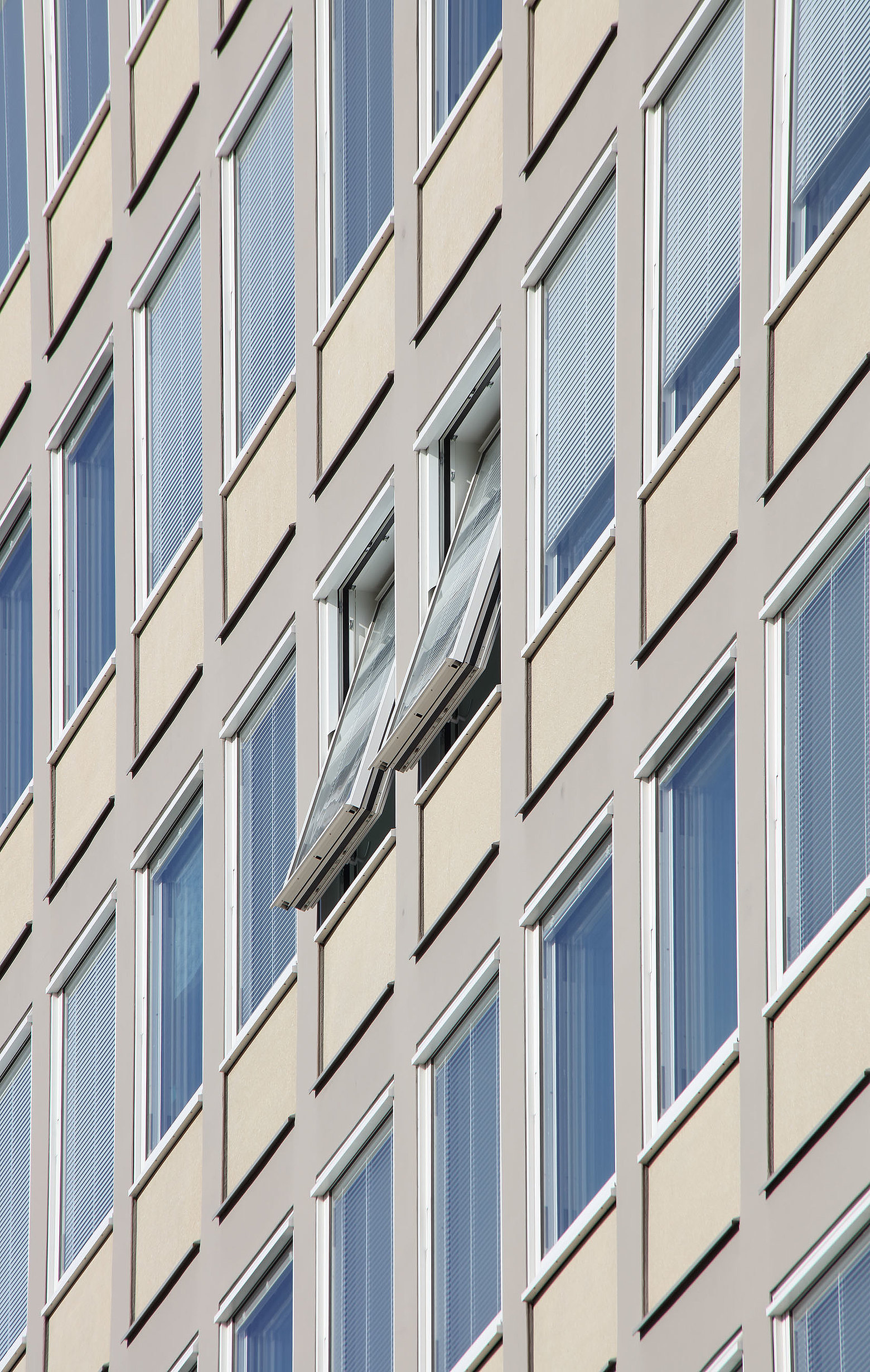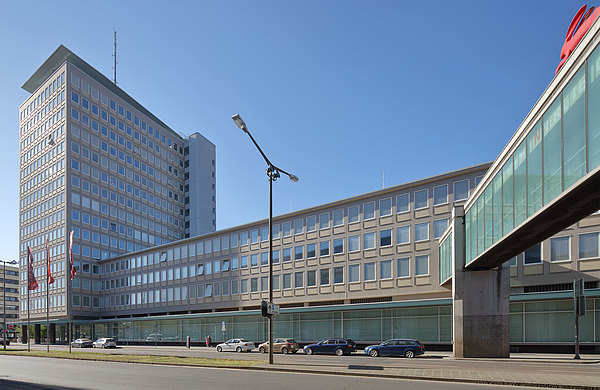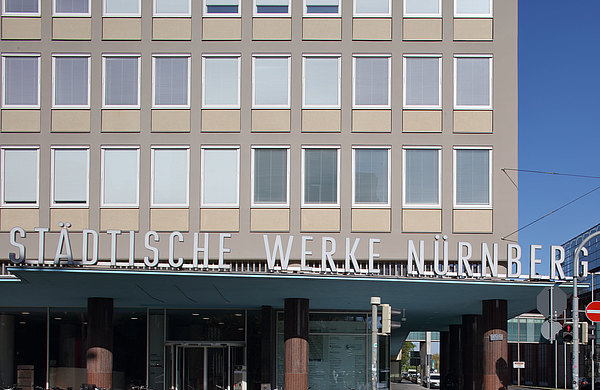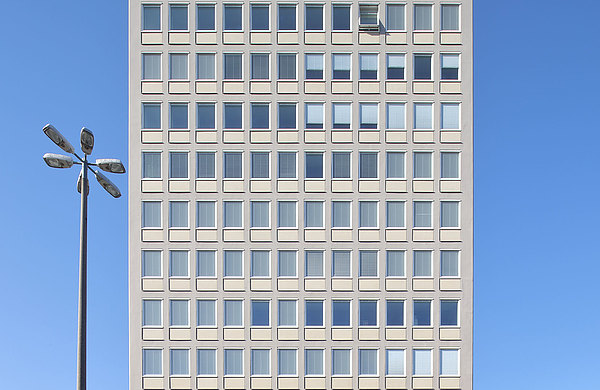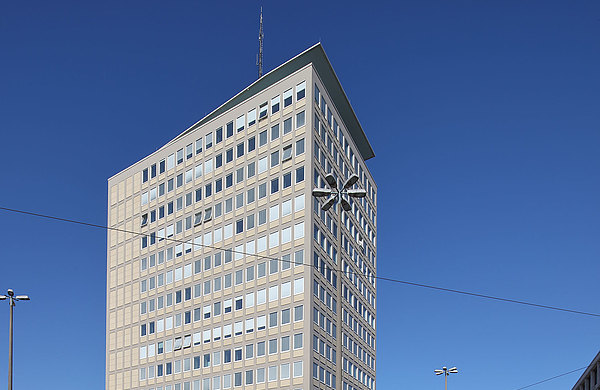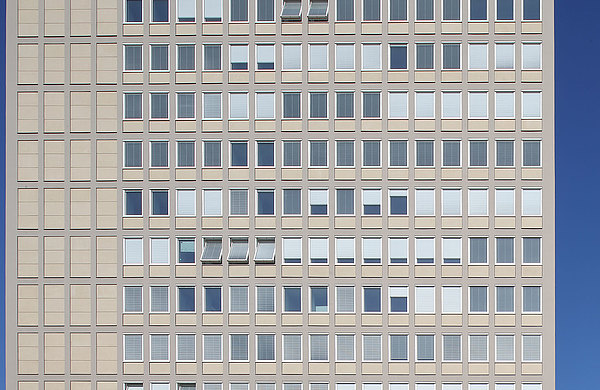Plärrer high-rise building
Built for tomorrow
At its opening in 1953, the 15-storey Plärrer high-rise building in Nuremberg was the highest building in Bavaria. The complex is characterised by around 1060 pivoting casement windows, which have been restored in a recent renovation project – in line with the preservation of historical monuments but without sacrificing modern requirements such as thermal insulation and durability.
The Plärrer high-rise building was completed in 1953 in the almost completely destroyed city of Nuremberg, according to plans by Wilhelm Schlegtendal. In addition to the high-rise building, the ensemble of the Nuremberg Municipal Works created at the time also includes a three-storey building wing. 1060 pivoting casement windows characterised these two components. However, due to the single glazing and correspondingly poor thermal insulation, all windows were replaced in the 1980s by better insulated, plain tilt-and-turn windows.
Faithfulness to the original
As the formerly highest building in Bavaria, the high-rise building "am Plärrer" has always been under the "particularly watchful eye of the office for protection of historical monuments". This is explained by Gunnar Sellien, the architect in charge of the project at the firm of Knerer und Lang, which was commissioned with the renovation. However, this project, which started in 2016, involved more than just bringing the entire building complex into line with the required standards for fire, heat and noise protection. "Another requirement was to restore the original appearance of the ensemble, which was declared a listed building in 1988," Sellien continues. Thus, a thermal insulation composite system had to be applied to the facade, consisting of window parapets made of pumice stone and a visible concrete construction. Another challenge was the faithful restoration of the filigree pivoting casement windows, which gave the appearance of the building its special flair. Tenders were invited for a "pivoting composite window with integrated sun protection and an internal pivoting sash for inspection and cleaning work, with a closed pivoting function". Jürg Egli, Head of Property Management at Forster Profile Systems, explains with a grin that this unwieldy technical term clearly describes the complexity of the technical development challenge.
After learning of this through a Europe-wide invitation to tender, Forster Profile Systems developed a prototype as a possible system provider together with the architects. Sellien, the architect in charge of the project, emphasised how impressed he was by the commitment of the Swiss company, which was prepared to develop a testable prototype. This not only made it possible to present the client from the N-ERGIE Aktiengesellschaft with a functioning window element but also to provide the required proof of mechanical stress, long-term function, impact resistance, sound insulation and condensation behaviour.
Heavyweights
The pivoting sashes of all windows can be imagined as a 16 cm thick box-type composite window with integrated sun protection. For inspection and cleaning purposes, this window and the glass panes can be accessed via an internal pivoting sash that is unlocked with a plug-in handle. While the external baffle plate is made of hardened LSG glass, the thermal insulation is provided by the triple insulation glazing, which is located in the inner inspection sash. All panes are untinted; the sun protection is provided by electric external blind slats.
The pivoting casement windows, each measuring H 1853 mm × W 1310 mm, are quite heavy at 250 kg and the outer frame weighs a further 50 kg. "Instead of placing the units weighing a total of 300 kg on the pumice parapets as before, they now rest on steel U-profiles that we have inserted between the facade supports," explains Gunnar Sellien.
Durability with a love for detail
The client attached great importance to the durability of the window frames; it was to far exceed the usual life cycle of 25 to 30 years. Three carefully planned details contribute significantly to the required durability of the solution: the pivot bearing, the insulator and the low coefficient of expansion of the steel frames. The pivot bearing is a thick-walled hollow pin with a diameter of 15 mm, through the inside of which the sun protection cabling runs. Since the pivoting windows only need to be opened by about 12 cm, the shearing angle is just 7.5°, which means low torsion for the low current cable integrated in the pivot bearing.
The pivoting frames are based on the forster unico profile. Forster does not rely on plastic insulators, which sit between the inner and outer strip galvanised steel frames, but on a high-quality stainless steel latticework. The great advantage of stainless steel is that it does not become brittle and fragile over the years like plastic. Furthermore, this insulator also reduces the fire load. In the case of fire, the insulator is not a fire accelerator and does not form any toxic gases either. Falling window half shells due to burning insulators cannot occur in this high-rise building. In the steel window construction, the frame corners are not bevelled but welded into one unit. As a result, there are no butt joints through which moisture can penetrate into the frames. Their surfaces were finished in the corrosivity category C4 and coated with a UV-resistant, light shade.
The pivoting windows are closed by means of four-sided fittings, which lock into their outer frames all around and tighten on all sides. This was the only way to achieve sufficient wind suction protection and watertightness for the high-rise building as well as the sound insulation requirement of 47 dB. As proof of its durability, Forster Profile Systems has subjected the pivoting casement window to a long-term functional test. In the process, the usual test series, which range between 5000 and 20,000 cycles, were exceeded by a factor of 10: Proof of 200,000 cycles was provided for the pivoting windows on the Plärrer high-rise.
Glass corners on the roof
In addition to the pivoting windows of the high-rise building and the three-storey workshop wing, the fixed glazing of the topmost staggered storey also had to be replaced. The mullion/transom system forster thermfix vario Hi was used here. It has a face width of only 45 mm and a Uf value of 0.49 W. It was therefore no problem to maintain the original character with a contemporary thermal insulation: The glass facade was tilted inwards in line with the original. In addition, the outer profile strips still show the heads of the screws that hold the glass in the substructure. The circumferential glazing has glass corners that are concealed by a narrow profile. Two exit windows designed in the forster unico system have been added. In the event of fire, they enable escape to the roof terrace.
After almost four years of renovation, the windows of the high-rise building "am Plärrer" are as attractive again as they were in 1953. "The original design language is visible again. Forster Profile Systems offered the best available technical solution," Gunnar Sellien is convinced.
Nuremberg, Germany
pivoting casement windows forster unico | exit windows forster unico
fixed glazing of the topmost staggered storey with the mullion/transom system forster thermfix vario Hi
Architects: Knerer und Lang Architekten GmbH
Metal engineers: MTZ Metalltechnik Zitzmann GmbH
Construction company: N-ERGIE Aktiengesellschaft
Sun protection manufacturer: WAREMA International GmbH

